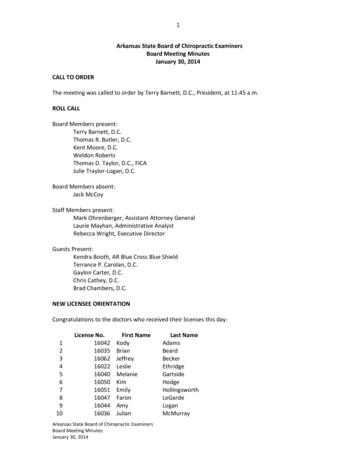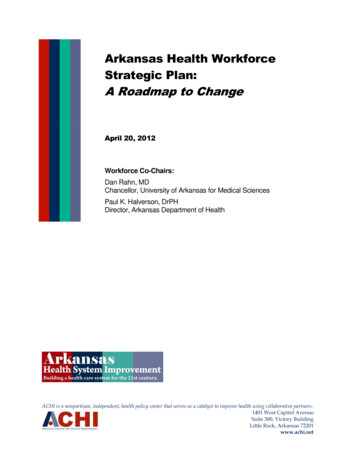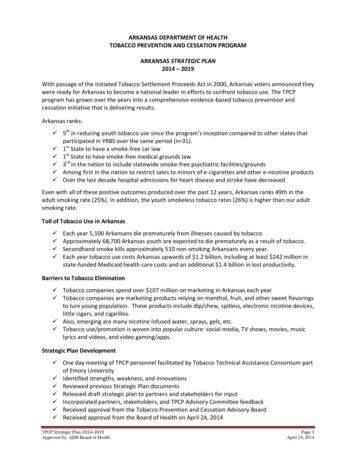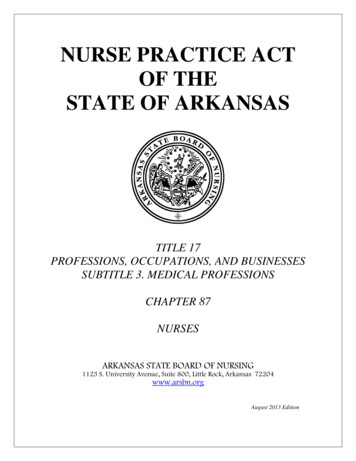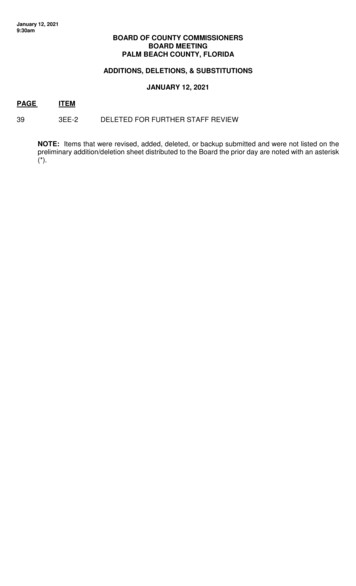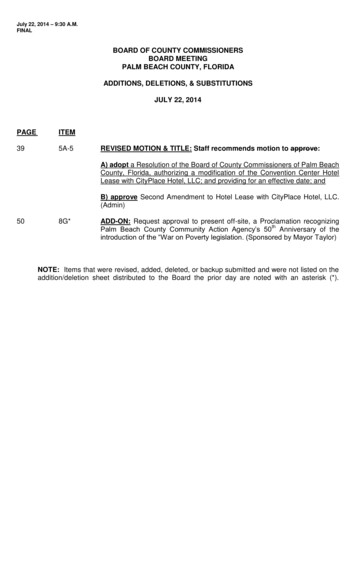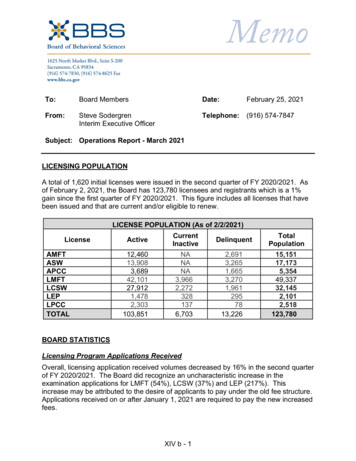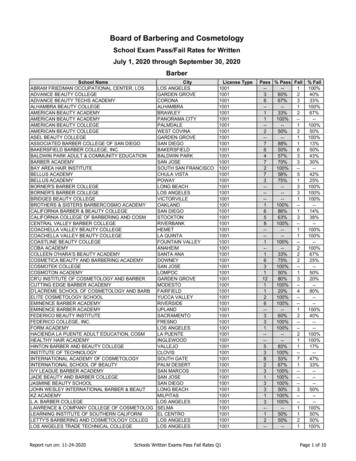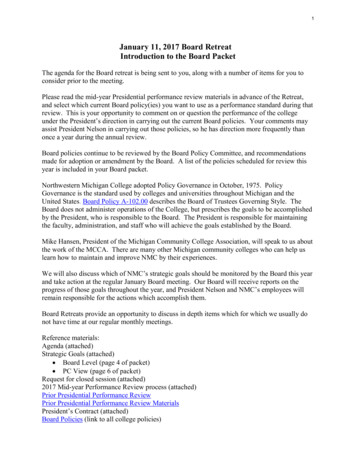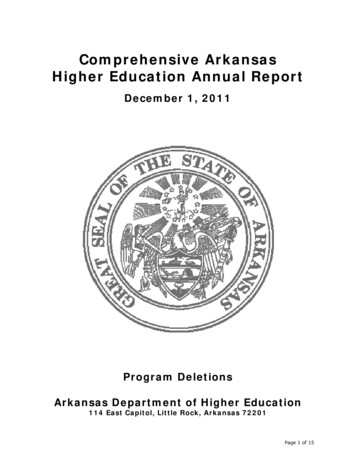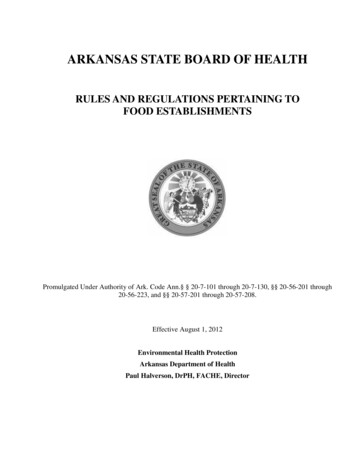
Transcription
ARKANSAS STATE BOARD OF HEALTHRULES AND REGULATIONS PERTAINING TOFOOD ESTABLISHMENTSPromulgated Under Authority of Ark. Code Ann.§ § 20-7-101 through 20-7-130, §§ 20-56-201 through20-56-223, and §§ 20-57-201 through 20-57-208.Effective August 1, 2012Environmental Health ProtectionArkansas Department of HealthPaul Halverson, DrPH, FACHE, Director
ContentsAUTHORITY7CHAPTER 1- PURPOSE AND DEFINITIONS8CHAPTER 2- MANAGEMENT AND PERSONNEL25CHAPTER 3 - FOOD35CHAPTER 4 - EQUIPMENT, UTENSILS, AND LINENS71CHAPTER 5 - WATER, PLUMBING, AND WASTE99CHAPTER 6 - PHYSICAL FACILITIES112CHAPTER 7 - POISONOUS OR TOXIC MATERIALS123CHAPTER 8 - COMPLIANCE AND ENFORCEMENT128Chapter 1Purpose and Definitions1-11-2TITLE, INTENT, S1-2018Applicability and Terms Defined9Chapter 2Management and 02Knowledge262-103Duties28EMPLOYEE HEALTH2-2012-32529Disease or Medical ConditionPERSONAL CLEANLINESS29312-301Hands and Arms312-302Fingernails332-303Jewelry332-304Outer Clothing331
2-4HYGIENIC PRACTICES342-401Food Contamination Prevention342-402Hair Restraints342-403Animals35Chapter S, SPECIFICATIONS, AND ORIGINALCONTAINERS AND RECORDS3-33-201Sources363-202Specifications for Receiving393-203Original Containers and Records41PROTECTION FROM CONTAMINATION AFTER RECEIVING3-301Preventing Contamination by Employees3-302Preventing Food and IngredientContamination3-3033-304434546Preventing Contamination from Equipment,Utensils, and Linens3-30543Preventing Contamination from Ice Used asa Coolant3-43647Preventing Contamination from thePremises493-306Preventing Contamination by Consumers503-307Preventing Contamination from Other Sources51DESTRUCTION OF ORGANISMS OF PUBLIC eheating563-404Other Methods572
3-5LIMITATION OF GROWTH OF ORGANISMS OF PUBLICHEALTH CONCERN3-6573-501Temperature and Time Control573-502Specialized Processing Methods62FOOD IDENTITY, PRESENTATION, AND ON-PREMISESLABELING3-73-601Accurate Representation663-602Labeling66CONTAMINATED FOOD3-7013-86668Disposition68SPECIAL REQUIREMENTS FOR HIGHLY SUSCEPTIBLEPOPULATIONS3-80169Additional Safeguards69Chapter 4Equipment, Utensils, and Linens4-14-24-3MATERIALS FOR CONSTRUCTION AND REPAIR4-101Multiuse714-102Single-Service and Single-Use73DESIGN AND CONSTRUCTION744-201Durability and unctionality764-205Acceptability81NUMBERS AND CAPACITIES824-301Equipment824-302Utensils, Temperature Measuring Devices,and Testing Devices4-471LOCATION AND 3
4-5MAINTENANCE AND OPERATION854-501Equipment854-502Utensils and Temperature and PressureMeasuring Devices4-64-74-84-988CLEANING OF EQUIPMENT AND hods92SANITIZATION OF EQUIPMENT AND 4-803Methods96PROTECTION OF CLEAN ITEMS964-901Drying964-902Lubricating and Reassembling974-903Storing974-904Handling98Chapter 5Water, Plumbing, and 3Quantity and Availability1005-104Distribution, Delivery, and Retention100PLUMBING SYSTEM1015-201Materials1015-202Design, Construction, and Installation1015-203Numbers and Capacities1025-204Location and Placement1035-205Operation and Maintenance1034
5-3MOBILE WATER TANK, SEASONAL RETAIL FOODESTABLISHMENT WATER TANK, PUSHCART WATERTANK AND COFFEE KIOSK RETAIL FOODESTABLISHMENT WATER TANK5-45-301Materials1055-302Design and Construction1055-303Numbers and Capacities1065-304Operation and Maintenance107SEWAGE, OTHER LIQUID WASTE, AND RAINWATER5-4015-5105107Mobile, Seasonal, Pushcart,Coffee Kiosk Holding Tank1075-402Retention, Drainage, and Delivery1085-403Disposal Facility109REFUSE, RECYCLABLES, AND RETURNABLES1095-501Facilities on the Premises1095-502Removal1125-503Facilities for Disposal and Recycling112Chapter 6Physical Facilities6-16-26-3MATERIALS FOR CONSTRUCTION AND REPAIR1126-101Indoor Areas1136-102Outdoor Areas113DESIGN, CONSTRUCTION, AND ility115NUMBERS AND CAPACITIES1176-301Handwashing Facilities1176-302Toilets and Dressing Areas and Lockers1196-306Service Sinks1195
6-46-5LOCATION AND PLACEMENT1196-401Handwashing Facilities1196-402Toilet Rooms1196-403Employee Accommodations1196-404Distressed Merchandise1206-405Refuse, Recyclables, and Returnables120MAINTENANCE AND OPERATION6-501120Premises, Structures, Attachments, andFixtures – Methods120Chapter 7Poisonous or Toxic Materials7-17-27-3LABELING AND IDENTIFICATION1237-101Original Containers1237-102Working Containers123OPERATIONAL SUPPLIES AND APPLICATIONS1247-201Storage1247-202Presence and Use1247-203Container 7-206Pesticides1277-207Medicines1277-208First Aid Supplies1277-209Other Personal Care Items127STOCK AND RETAIL SALE7-301128Storage and Display128Chapter 8Compliance and Enforcement8-1CODE APPLICABILITY1288-101Use for Intended Purpose1298-102Additional Requirements1298-103Variances1296
8-28-38-48-5PLAN SUBMISSION AND APPROVAL1308-201Facility and Operating Plans1308-202Confidentiality1328-203Construction Inspection and Approval132PERMIT TO Conditions of Retention135INSPECTION AND CORRECTION OF rt of Findings1398-404Imminent Health Hazard1408-405Critical Violation1418-406Noncritical Violation141PREVENTION OF FOODBORNE DISEASETRANSMISSION BY EMPLOYEES8-5018-6137141Investigation and ControlLEGAL ACTIONS1421438-601Criminal Proceedings1438-602Civil Proceedings143SEVERABILITY143REPEAL143AUTHORITYThe following Rules and Regulations Pertaining to Retail Food Establishments are duly adoptedand promulgated by the Arkansas State Board of Health pursuant to the authority expresslyconferred by the Laws of the State of Arkansas including, without limitation, Act 96 of 1913 (Ark.Code Ann.§ § 20-7-101 through 20-7-130) and Act 415 of 1953 (Ark. Code Ann. §§ 20-56-201through 20-56-223) and Act 357 of 1977 Ark. Code Ann. §§ 20-57-201 through 20-57-208).7
Chapter1Purpose and DefinitionsParts1-1TITLE, INTENT, SCOPE1-2DEFINITIONS1-1TITLE, INTENT, -101.10Food Code.These provisions shall be known as the Food Code, hereinafter referred toTHESERULES AND REGULATIONS OR THIS REGULATION.Intent1-102.10Food Safety, Illness Prevention, and Honest Presentation.The purpose of THESE RULES AND REGULATIONS is to safeguard public health andprovide to CONSUMERS FOOD that is safe, unADULTERATED, and honestly presented.Scope1-103.10Statement.THESE RULES AND REGULATIONS establishes definitions; sets standards formanagement and personnel, FOOD operations, and EQUIPMENT and facilities;provides for FOOD ESTABLISHMENT plan review, PERMIT issuance, inspection,EMPLOYEE RESTRICTION, and PERMIT suspension.1-2DEFINITIONSSubpart1-201Applicability and Terms Defined8and
Applicability and Term Defined1-201.10Statement of Application of Listing of Terms.(A) The following definitions apply in the interpretation and application of THESE RULES ANDREGULATIONS.(B) Terms Defined.Accredited program.(1)"Accredited program" means a food protection manager certification programthat has been evaluated and listed by an accrediting agency as conforming tonational standards for organizations that certify individuals.(2)"Accredited program" refers to the certification process and is a designationbased upon an independent evaluation of factors such as the sponsor'smission; organizational structure; staff resources; revenue sources; policies;public information regarding program scope, eligibility requirements, recertification, discipline and grievance procedures; and test development andadministration.(3) "Accredited program" does not refer to training functions or educationalprograms.Additive.(1) "Food additive" has the meaning stated in the Federal Food, Drug, andCosmetic Act, § 201(s) and 21 CFR 170.(2) "Color additive" has the meaning stated in the Federal Food, Drug, andCosmetic Act, § 201(t) and 21 CFR 70."Adulterated" has the meaning stated in the Federal Food, Drug, and CosmeticAct, § 402."Approved" means acceptable to the REGULATORY AUTHORITY based on a determinationof conformity with principles, practices, and generally recognized standards that protectpublic health."aw" means water activity which is a measure of the free moisture in a FOOD, is thequotient of the water vapor pressure of the substance divided by the vapor pressure ofpure water at the same temperature, and is indicated by the symbol aw.Bed and Breakfast is an establishment offering lodging and breakfast which mustcomply with this Regulation if its food service facility is operated in connection with 6 ormore sleeping rooms and/or more than 10 people."Beverage" means a liquid for drinking, including water."Bottled drinking water" means water that is SEALED in bottles, packages, or othercontainers and offered for sale for human consumption, including bottled mineral water."Casing" means a tubular container for sausage products made of either natural orartificial (synthetic) material."Certification number" means a unique combination of letters and numbers assignedby a SHELLFISH CONTROL AUTHORITY to a MOLLUSCAN SHELLFISH dealer according to theprovisions of the National Shellfish Sanitation Program.9
CIP.(1) "CIP" means cleaned in place by the circulation or flowing by mechanicalmeans through a piping system of a detergent solution, water rinse, andSANITIZING solution onto or over EQUIPMENT surfaces that require cleaning, suchas the method used, in part, to clean and SANITIZE a frozen dessert machine.(2) "CIP" does not include the cleaning of EQUIPMENT such as band saws, slicers,or mixers that are subjected to in-place manual cleaning without the use of aCIP system."CFR" means CODE OF FEDERAL REGULATIONS. Citations in this Code to the CFR refersequentially to the Title, Part, and Section numbers, such as 21 CFR 178.1010 refers toTitle 21, Part 178, Section 1010."Code of Federal Regulations" means the compilation of the general and permanentrules published in the Federal Register by the executive departments and agencies ofthe federal government which:(1) Is published annually by the U.S. Government Printing Office; and(2) Contains FDA rules in 21 CFR, USDA rules in 7 CFR and 9 CFR, EPA rules in40 CFR, and Wildlife and Fisheries rules in 50 CFR.“Coffee Kiosk” means:(1) An establishment limited to the preparation and service of coffee basedproducts.(2) Items that are offered for sale that are not coffee based drinks must be offeredin pre-packaged form and not requiring refrigeration."Commingle" means:(1) To combine SHELLSTOCK harvested on different days or from different growingareas as identified on the tag or label, or(2) To combine SHUCKED SHELLFISH from containers with different container codesor different shucking dates.Comminuted.(1) "Comminuted" means reduced in size by methods including chopping,flaking, grinding, or mincing.(2) "Comminuted" includes FISH or MEAT products that are reduced in size andrestructured or reformulated such as gefilte FISH, gyros, ground beef, andsausage; and a mixture of 2 or more types of MEAT that have been reduced insize and combined, such as sausages made from 2 or more MEATS.“Commissary” means a catering operation, restaurant, central preparation facility, orany other place in which food, containers or supplies are kept, handled, prepared,packaged or stored."Confirmed disease outbreak" means a FOODBORNE DISEASE OUTBREAK in whichlaboratory analysis of appropriate specimens identifies a causative agent andepidemiological analysis implicates the FOOD as the source of the illness."Consumer" means a PERSON who is a member of the public, takes possession ofis not functioning in the capacity of an operator of a FOOD ESTABLISHMENT or FOODPROCESSING PLANT, and does not offer the FOOD for resale.10FOOD,
"Corrosion-resistant material" means a material that maintains acceptable surfaceclean ability characteristics under prolonged influence of the FOOD, to be contacted, thenormal use of cleaning and SANITIZING solutions, and other conditions of the useenvironment."Critical control point" means a point or procedure in a specific FOOD system whereloss of control may result in an unacceptable health RISK.Critical Item (Priority Item or Priority Foundation Item).(1) "Priority item" means a provision in this Code whose application contributesdirectly to the elimination, prevention or reduction to an acceptable level, hazardsassociated with food borne illness or injury and there is no other provision thatmore directly controls the hazard."Priority item" includes items with a quantifiable measure to show control ofhazards such as cooking, reheating, cooling, handwashing; and is an item that isdenoted in this Code with a superscript P- P.(2) "Priority Foundation Item” means a provision of THESE RULES AND REGULATIONSwhose application supports, facilitates or enables one or more PRIORITY ITEMS.Core Item(1) “Core item” means a provision in this Code that is not designated as a PRIORITYITEM OR A PRIORITY FOUNDATION ITEM.(2) "Core item" includes an item that usually relates to general sanitation,operational controls, sanitation standard operating procedures (SSOPs), facilitiesor structures, equipment design, or general maintenance."Critical limit" means the maximum or minimum value to which a physical, biological, orchemical parameter must be controlled at a CRITICAL CONTROL POINT to minimize the RISKthat the identified FOOD safety HAZARD may occur.“Cut leafy greens” means fresh leafy greens whose leaves have been cut, shredded,sliced, chopped, or torn. The term “leafy greens” includes iceberg lettuce, romainelettuce, leaf lettuce, butter lettuce, baby leaf lettuce (i.e., immature lettuce or leafygreens), escarole, endive, spring mix, spinach, cabbage, kale, arugula, and chard. Theterm “leafy greens” does not include herbs such as cilantro or parsley.“Dealer” means a PERSON who is authorized by a SHELLFISH CONTROL AUTHORITY for theactivities of SHELLSTOCK shipper, shucker-packer, repacker, reshipper, or depurationprocessor of MOLLUSCAN SHELLFISH according to the provisions of the National ShellfishSanitation Program.“Disclosure” means a written statement that clearly identifies the animal-derivedFOODS which are, or can be ordered, raw, undercooked, or without otherwise beingprocessed to eliminate pathogens, or item that contain an ingredient that is raw,undercooked, or without otherwise being processed to eliminate pathogens.Day Care Family Home is a facility where children are cared for in a caregivers ownfamily residence which routinely serves more than 10 children with a maximum of 16under the purview of the Child Care Facility Licensing Act, Act 434 of 1969, which mustmeet the requirements of the Regulation.11
Drinking Water.(1) "Drinking water" means water that meets 40 CFR 141 National PrimaryDrinking Water Regulations.(2) "Drinking water" is traditionally known as "potable water."(3) "Drinking water" includes the term "water" except where the term usedconnotes that the water is not potable, such as "boiler water," "mop water,""rainwater," "wastewater," and "nondrinking" water."Dry storage area" means a room or area designated for the storage of PACKAGED orcontainerized bulk FOOD that is not POTENTIALLY HAZARDOUS and dry goods such asSINGLE-SERVICE items.Easily Cleanable means that surfaces are readily accessible and made of suchmaterials and finish and so fabricated that residue may be effectively removed by normalcleaning methods."Easily movable" means:(1) Portable; mounted on casters, gliders, or rollers; or provided with a mechanicalmeans to safely tilt a unit of EQUIPMENT for cleaning; and(2) Having no utility connection, a utility connection that disconnects quickly, or aflexible utility connection line of sufficient length to allow the EQUIPMENT to bemoved for cleaning of the EQUIPMENT and adjacent area.Egg.(1)”Egg” means the shell EGG of avian species such as chicken, duck,goose, guinea, quail, RATITES or turkey.(2) "Egg" does not include:(a) A BALUT;(b) The egg of reptile species such as alligator; or(c) An EGG PRODUCT.Egg Product.(1)"Egg Product" means all, or a portion of, the contents found insideEGGSseparated from the shell and pasteurized in aPLANT,FOOD PROCESSINGwith or without added ingredients, intended for humanconsumption, such as dried, frozen or liquid eggs.(2)"Egg Product" does not include FOOD which contains EGGS only ina relatively small proportion such as cake mixes."Employee" means the PERMIT HOLDER, PERSON IN CHARGE, PERSON having supervisoryor management duties, PERSON on the payroll, family member, volunteer, PERSONperforming work under contractual agreement, or other PERSON working in a RETAIL FOODESTABLISHMENT.12
“Enterohemorrhagic Escherichia Coli” (EHEC) means E. coli which causehemorrhagic colitis, meaning bleeding enterically or bleeding from the intestine. Theterm is typically used in association with E. coli that has the capacity to produce Shigatoxins and to cause attaching and effacing lesions in the intestine. EHEC is a subset ofSTEC, whose members produce additional virulence factors. Infections with EHEC maybe asymptomatic but are classically associated with bloody diarrhea (hemorrhagic colitis)and hemolytic uremic syndrome (HUS) or thrombotic thrombocytopenic purpura (TTP).Examples of serotypes of EHEC include: E. coli 0157:H7; E. coli 0157:NM; E. coli026:H11; E. coli 0145:NM; E. coli 0103:H2; or E. coli 0111:NM. Also see SHIGATOXIN-PRODUCING E. coli."EPA" means the U.S. Environmental Protection Agency.Equipment.(1) "Equipment" means an article that is used in the operation of a RETAIL FOODSERVICE ESTABLISHMENT such as a freezer, grinder, hood, ice maker, MEATblock, mixer, oven, reach-in refrigerator, scale, sink, slicer, stove, table,TEMPERATURE MEASURING DEVICE for ambient air, VENDING MACHINE, orWAREWASHING machine.(2) "Equipment" does not include items used for handling or storing largequantities of PACKAGED FOODS that are received from a supplier in a cased oroverwrapped lot, such as hand trucks, forklifts, dollies, pallets, racks, andskids."Exclude" means to prevent a PERSON from working as a FOOD EMPLOYEE or entering aFOOD ESTABLISHMENT except for those areas open to the general public."FDA" means the U.S. Food and Drug Administration.Fish.(1) "Fish" means fresh or saltwater finfish, crustaceans and other forms ofaquatic life (including alligator, frog, aquatic turtle, jellyfish, sea cucumber, andsea urchin and the roe of such animals) other than birds or mammals, and allmollusks, if such animal life is intended for human consumption.(2) "Fish" includes an edible human FOOD product derived in whole or in part fromFISH, including FISH that have been processed in any manner."Food" means a raw, cooked, or processed edible substance, ice, BEVERAGE, oringredient used or intended for use or for sale in whole or in part for human consumption,or chewing gum."Food borne disease outbreak" means the occurrence of two or more cases of asimilar illness resulting from the ingestion of a common food."Food-contact surface" means:(1) A surface of EQUIPMENT or a UTENSIL with which FOOD normally comes intocontact; or(2) A surfaces of EQUIPMENT or a UTENSIL from which FOOD may drain, drip, orsplash:(a) Into a FOOD, or(b) Onto a surface normally in contact with13FOOD.
"Food employee" means an individual working with unPACKAGED FOOD, FOOD EQUIPMENTor UTENSILS, or FOOD-CONTACT SURFACES.Food Processing Plant.(1) "Food processing establishment plant" means a commercial operation thatmanufactures, packa
ARKANSAS STATE BOARD OF HEALTH RULES AND REGULATIONS PERTAINING TO FOOD ESTABLISHMENTS Promulgated Under Authority of Ark. Code Ann.§ § 20-7-101 through 20-7-130, §§ 20-56-201 through 20-56-223, and §§ 20-57-201 through 20-57-208. Effective August 1, 2012 Environmental Health
